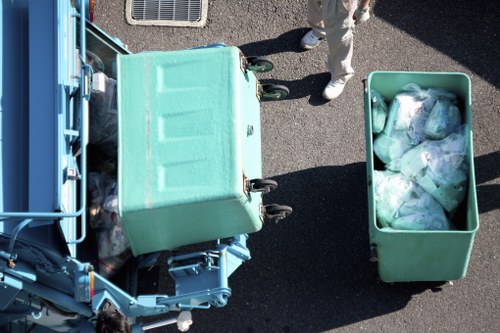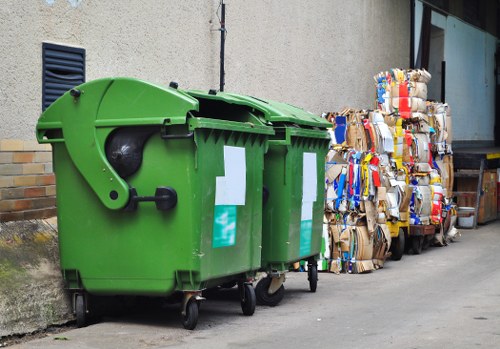Efficient Strategies for Large Item Collection in Mega Waste Management

Introduction to Large Item Collection
Managing mega waste involves handling a variety of bulky items that cannot be disposed of through regular waste collection methods. These large items, often referred to as bulk waste, include furniture, appliances, electronics, and more. Efficient collection of these items is crucial for maintaining cleanliness, promoting recycling, and ensuring environmental sustainability.
In urban areas, the accumulation of large waste items can pose significant challenges. Without proper mechanisms for disposal, these items can lead to cluttered streets, blocked pathways, and increased risks of accidents. Therefore, establishing a robust large item collection system is essential for both municipal authorities and private waste management companies.
This article delves into the comprehensive strategies and best practices for large item collection within the realm of mega waste management.

Understanding Mega Waste
Definition and Scope
Mega waste refers to the substantial volume of waste generated by large populations, industrial activities, and urbanization. This type of waste includes not only large items but also massive quantities of smaller debris that require specialized collection and processing methods.
The scope of mega waste management extends beyond mere collection. It encompasses the entire lifecycle of waste handling, from generation and transportation to recycling and final disposal. Effective management of mega waste is vital for reducing environmental impact and promoting sustainable living.
Key components of mega waste management include:
- Collection and transportation of large items
- Recycling and repurposing materials
- Safe disposal in designated landfills
- Public education and engagement

Challenges in Large Item Collection
Logistical Issues
One of the primary challenges in large item collection is the logistical complexity involved. Unlike regular waste, bulky items require specialized vehicles for transportation. These vehicles must be equipped to handle heavy loads and navigate through urban infrastructures, which can include narrow streets and densely populated areas.
Additionally, coordinating collection schedules to minimize disruption to residents and businesses is a significant hurdle. Efficient routing and scheduling are essential to ensure timely pickups without causing traffic congestion or other urban inconveniences.
Environmental Considerations
Large waste items often contain materials that are harmful to the environment if not properly managed. For instance, electronic waste can contain hazardous substances like lead and mercury, while old appliances may contain refrigerants that contribute to greenhouse gas emissions. Ensuring that these items are collected and processed in an environmentally responsible manner is crucial.
Furthermore, improper disposal can lead to land contamination and pose health risks to communities. Therefore, stringent environmental regulations must be adhered to during the collection and disposal processes.

Best Practices for Effective Collection
Scheduling and Coordination
Implementing a well-organized scheduling system is vital for the seamless collection of large items. Utilizing advanced software can aid in optimizing routes, managing pickup requests, and ensuring that resources are allocated efficiently.
Coordination between various stakeholders, including municipal authorities, waste management companies, and the public, is essential. Clear communication channels and transparent processes help in minimizing misunderstandings and enhancing overall efficiency.
Resource Allocation
Proper allocation of resources, such as specialized vehicles and trained personnel, is fundamental to successful large item collection. Investing in reliable equipment and continuous training ensures that the workforce is capable of handling the demands of mega waste management.
- Deploying vehicles with appropriate weight capacities
- Ensuring availability of necessary tools and equipment
- Providing ongoing training for staff

Recycling and Repurposing
Maximizing Material Recovery
Recycling plays a pivotal role in large item collection by enabling the recovery of valuable materials. Metals, plastics, and glass from bulky items can be repurposed, reducing the need for virgin resources and minimizing environmental impact.
Establishing partnerships with recycling facilities ensures that collected items are processed appropriately. Implementing sorting systems at collection points can enhance the efficiency of material recovery and streamline the recycling process.
Repurposing Initiatives
Beyond recycling, repurposing offers innovative solutions for large waste items. Furniture, for example, can be refurbished and donated to charitable organizations, extending its lifecycle and providing benefits to the community.
Encouraging creative repurposing initiatives not only reduces waste but also fosters a culture of sustainability and responsibility among the public.

Technology in Large Item Collection
Automation and Smart Systems
Advancements in technology have transformed the landscape of large item collection. Automated systems and smart technologies enable more efficient management of waste collection processes.
For instance, GPS tracking allows for real-time monitoring of collection vehicles, optimizing routes and ensuring timely pickups. Additionally, smart bins equipped with sensors can notify waste management services when they are full, allowing for proactive collection.
Data Analytics
Leveraging data analytics can provide valuable insights into waste generation patterns and collection efficacy. Analyzing data helps in identifying peak times, high-demand areas, and potential bottlenecks, facilitating data-driven decision-making to enhance overall efficiency.
- Predictive analytics for demand forecasting
- Performance metrics tracking
- Optimization of resource deployment

Community Engagement and Education
Public Awareness Campaigns
Engaging the community is essential for the success of large item collection initiatives. Public awareness campaigns educate residents about proper disposal methods, recycling practices, and the importance of responsible waste management.
Effective communication strategies, such as informative websites, social media outreach, and local events, can enhance community participation and support for mega waste management programs.
Incentive Programs
Incentivizing residents to participate in large item collection can significantly improve participation rates. Incentive programs might include discounts on disposal fees, rewards for recycling, or recognition for environmentally responsible behavior.
- Recycling rewards programs
- Discounts for bulk waste disposal
- Community recognition initiatives

Regulatory Framework and Compliance
Understanding Regulations
Compliance with local, state, and federal regulations is non-negotiable in large item collection. Waste management authorities must stay informed about relevant laws and standards to ensure that their practices meet all legal requirements.
Regulations often dictate the proper handling, transportation, and disposal methods for various types of waste. Adhering to these regulations not only ensures legal compliance but also promotes environmental protection and public safety.
Implementing Best Practices
Aligning collection practices with regulatory standards requires the implementation of best practices. This includes maintaining accurate records, conducting regular audits, and adopting environmentally friendly disposal methods.
- Regular compliance audits
- Adoption of eco-friendly disposal technologies
- Comprehensive training programs for staff

Case Studies: Successful Large Item Collection Programs
City A's Innovative Approach
City A implemented an innovative large item collection program that significantly reduced mega waste accumulation. By integrating smart technology and community engagement, the city achieved a 30% increase in efficient waste pickups.
The program focused on:
- Utilizing GPS-enabled vehicles for optimized routing
- Launching a user-friendly online scheduling system
- Conducting regular public education workshops
Town B's Recycling Revolution
In Town B, the introduction of specialized recycling centers for large items revolutionized waste management. The centers facilitated the sorting and processing of bulk waste, ensuring maximum material recovery and minimal environmental impact.
Key initiatives included:
- Establishing partnerships with local recycling firms
- Implementing automated sorting technologies
- Promoting repurposing projects within the community

Future Trends in Mega Waste Management
Sustainable Practices
The future of large item collection lies in adopting sustainable practices that prioritize environmental preservation. Innovations such as circular economy models and zero-waste initiatives are set to reshape mega waste management.
Emphasizing sustainability involves:
- Maximizing material reuse and recycling
- Minimizing waste generation through efficient design
- Encouraging community participation in sustainability efforts
Technological Advancements
Emerging technologies will continue to revolutionize large item collection. Advances in automation, artificial intelligence, and Internet of Things (IoT) devices will enhance the efficiency and effectiveness of waste management systems.
Potential technological innovations include:
- Autonomous waste collection vehicles
- AI-driven waste sorting systems
- IoT-enabled smart waste management infrastructure
Embracing Innovation for a Cleaner Future
By embracing innovation and sustainability, mega waste management can achieve significant environmental benefits. Continuous improvement and adaptation to new technologies and practices are essential for addressing the evolving challenges of large item collection.
Conclusion
Effective large item collection is a cornerstone of successful mega waste management. By understanding the challenges, implementing best practices, leveraging technology, and engaging the community, municipalities and waste management companies can significantly reduce the environmental impact of bulky waste.
As urban populations grow and waste generation continues to increase, the importance of efficient large item collection will only become more pronounced. Investing in robust waste management systems today ensures a cleaner, healthier, and more sustainable future for generations to come.
Contact us today to learn more about how our waste management solutions can help your community achieve efficient and sustainable large item collection.